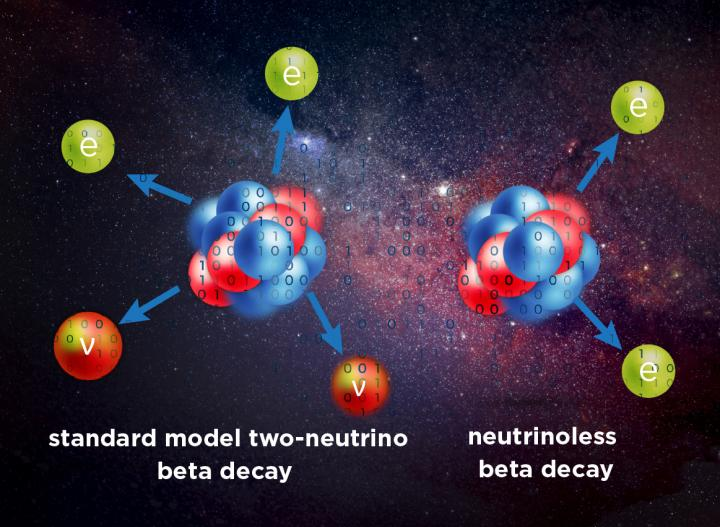Jul 7 2020
At the Facility for Rare Isotope Beams (FRIB) Laboratory of the Michigan State University (MSU), scientists have achieved a major breakthrough in the theoretical first-principles description of neutrinoless double-beta decay.
 Researchers have developed a new approach to model a yet-unconfirmed rare nuclear process. The binary code (1, 0) on the particles in the graphic symbolizes the computer simulations, which will be performed to better understand neutrinoless double-beta decay. Certain nuclei decay by emitting electrons (e) and neutrinos (?), but the existence of a neutrinoless double-beta decay has been hypothesized. Image Credit: Facility for Rare Isotope Beams.
Researchers have developed a new approach to model a yet-unconfirmed rare nuclear process. The binary code (1, 0) on the particles in the graphic symbolizes the computer simulations, which will be performed to better understand neutrinoless double-beta decay. Certain nuclei decay by emitting electrons (e) and neutrinos (?), but the existence of a neutrinoless double-beta decay has been hypothesized. Image Credit: Facility for Rare Isotope Beams.
The observation of this rare nuclear process, which has not been confirmed yet, would have crucial implications for cosmology and particle physics. Theoretical simulations are vital to the planning and assessment of proposed experiments. The researchers described the outcomes in an article published recently in Physical Review Letters.
FRIB theorists Jiangming Yao, a research associate and the study’s lead author, Roland Wirth, a research associate, and Heiko Hergert, an assistant professor, are members of a topical collaboration that focuses on neutrinoless double-beta decay and fundamental symmetries.
The topical collaboration is funded by the U.S. Department of Energy Office of Science Office of Nuclear Physics. The theorists collaborated with fellow topical collaboration members from the University of North Carolina-Chapel Hill and other collaborators from the Universidad Autonoma de Madrid, Spain.
The study is regarded as a crucial milestone in the theoretical prediction of neutrinoless double-beta decay rates with completely controlled, measured uncertainties.
The researchers created the new In-Medium Generator-Coordinate Method (IM-GCM). It is an innovative method to model the interactions between nucleons and can describe the candidate nuclei’s complex structure for this kind of decay.
The first-ever use of IM-GCM for quantifying the neutrinoless double beta decay rate for the calcium-48 nucleus has set the stage for exploring other candidates that exhibit controllable theoretical uncertainty.
In the case of neutrinoless double-beta decay, two protons transform into neutrons at the same time without the release of the two neutrinos that occur in more typical weak-interaction processes.
If it still occurs, this is a very rare and unique decay that is anticipated to have a half-life of more than 10 septillion years (1 followed by 25 zeroes). This means that half of a sample of nuclei would have experienced neutrinoless double beta-decay in this extremely long period.
Its observation would show that neutrinos tend to be their own antiparticles. Each subatomic particle has its antiparticle with the same mass but an equal and opposite charge. Mutual annihilation of particles and antiparticles can occur, with the release of only energy. Thus, in neutrinoless double-beta decay, no neutrinos would be observed.
The observation of a neutrinoless double-beta decay would demonstrate that a fundamental law—the lepton number conservation—is violated in nature. This could help elucidate the reason for the presence of more matter than antimatter in the universe, where the antimatter includes the antiparticles mentioned above. In addition, the observation would pave the way for attempts to complete the Standard Model of particle physics.
The absence of neutrinos in this yet-unconfirmed decay makes it possible to determine the neutrino masses. These masses are an important parameter in models of the evolution of the universe. The theoretical decay rate is a key ingredient in the extraction of the neutrino masses from the measured lifetime, or at least provides new upper limits on these quantities.
Heiko Hergert, Assistant Professor, Facility for Rare Isotope Beams, Michigan State University
Moreover, theoretical calculations such as those proposed by the researchers will help ascertain the size of the detectors required for large-scale neutrinoless double-beta decay experiments.
The development and implementation of tests of fundamental symmetries is a crucial aspect of FRIB’s mission. Experiments at FRIB investigate the structure of neutrinoless double-beta decay candidates and their adjacent isotopes.
This fact has an impact on the rate at which the decay could occur. Researchers can now apply the theoretical techniques proposed for this study to other nuclei that exhibit complex structures and are investigated at FRIB.
Journal Reference:
Yao, J. M., et al. (2020) Ab Initio Treatment of Collective Correlations and the Neutrinoless Double Beta Decay of 48Ca. Physical Review Letters. doi.org/10.1103/PhysRevLett.124.232501.